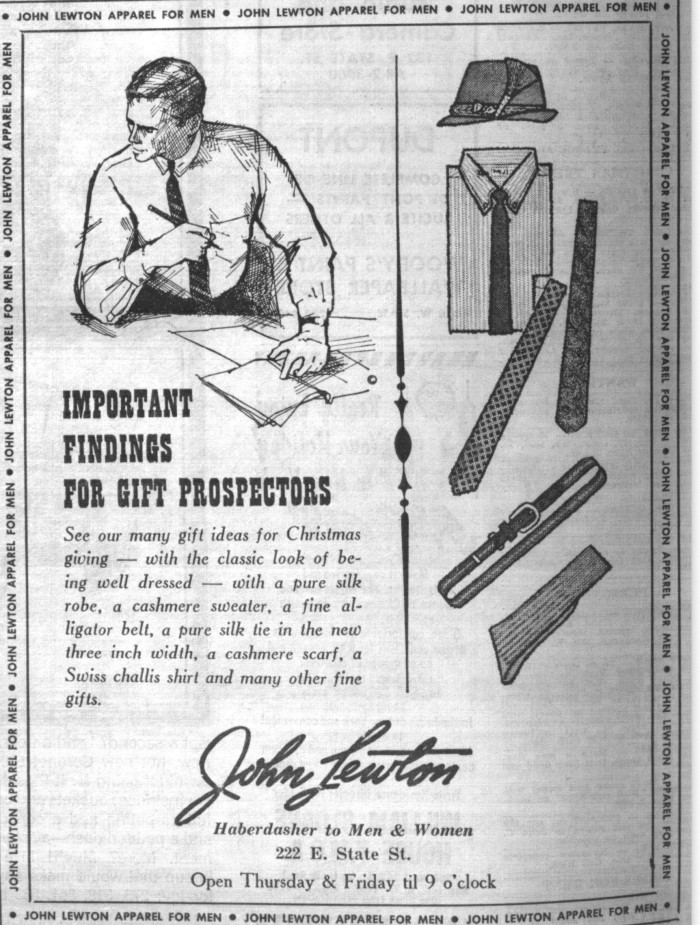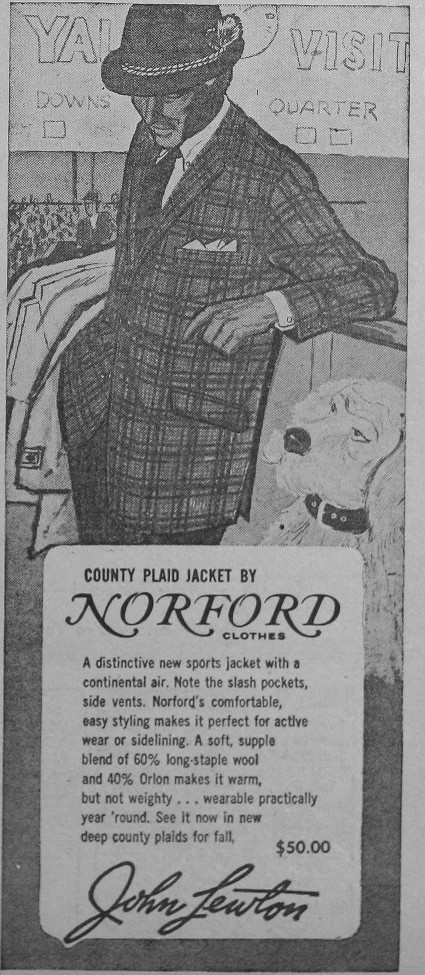Roger Sack, Cornell class of 1962, was a young man who knew clothes. He inherited a sense of style from his father, who, though the son of poor immigrants, shopped at Rogers Peet, Brooks Brothers and Paul Stuart. He was a man of “refined taste,” remembers Sack, whose souvenir from World War II was a bolt of tweed from Scotland for a Balmacaan coat. When it came time for his Bar Mitzvah, Sack wore a gray flannel suit with tattersall vest from Rogers Peet. And when he went to Cornell, the shop that most resembled the ones he knew from New York was John Lewton.
“John Lewton could pass for Old Money,” remembers Sack. “Mr. Lewton was an imposing character, husky, broad-shouldered and quite good looking. He was the type of guy who got his clothes at J. Press, Paul Stuart and Chipp.”
Lewton was born May 30, 1904, and hailed from the town of East Liverpool, Ohio. Not much is known about his early life. He wanted to be an opera singer, according to Sam Bonnani, former buyer for the Cornell University Store and one-time employee of Lewton’s. He moved to New York, where he immersed himself in the world of opera before leaving the city for Ithaca. There Lewton found work with David Saperstone, owner of The Sports Shop. Here Lewton meet Clara Patterson, the store’s bookkeeper, and soon the two were married.
In 1946 the couple opened a shop at 222 East State Street. The four-story building was known as the Naughton-Brown building and since 1910 had been been occupied by a tailor named Emil Kohn. The building was known for its rounded windows on the third floor and the pressed tin wall and ceilings on the first floor. John and Clara would live and work out of this building for the next 31 years.
The John Lewton shop opened its doors on November 28th. Lewton made the announcement to the Cornell community through an ad in the student newspaper. Although not solely a college shop, Lewton was a loyal advertiser in the Cornell Daily Sun, which would feature his products in student fashion pictorials during the ’50s. “Lewton liked to hire students and did a good business with the fraternities,” remembers former employee Sam Bonnani. “He would send his student representative to the fraternities with a suitcase full of ties, ascots, and shirting samples.”
John Lewton was a top-quality campus shop, recalls Bob Freudenheim, a third-generation menswear clothier. The windows were impeccable and very clubby, says Freudenheim, and made you want to see the goods inside. Those goods included tweed and Shetland suits and sportcoats; challis, foulard and rep ties; English and Scottish knitwear; tab and buttondown shirts; Casswell & Massey fragrance; and alligator-hide accessories. Brands included Lacoste, Fred Perry, Sero, Barracuta, Corbin and suits from Naturalaire. Jackets were soft shouldered, three-button models and custom tailoring was available.
Lewton did not like change for change’s sake, says Bonnani, and was suspicious of schemes such as the closing of the street to create a pedestrian mall called The Commons. Still, he knew that on the clothing front he had to be nimble. A page in the September 23, 1969 issue of the Cornell Daily Sun carried an advertisement for the film “Midnight Cowboy” on the left and an advertisement for John Lewton on the right. It was perhaps a bit jarring to see them together, but the Lewton advertisement is transitional, as far as the Ivy heyday goes. It still recommends the university-style suit model it calls the Brooks, but the ad also promotes a new two-button model, fitted and with a deep vent. It was clear that the times were changing.
Looking at Lewton’s ads of the period, one can see how he navigated the post-Ivy era. One could put together an outfit comprised of Austin Hill tartan trousers, Braemar sweater, and Gordon-Ford jacket of corduroy or tweed, and come up with a higher-end version of a look not much different from what Playboy was showing in its fashion pictorials. However, at one point the haberdasher ran afoul of one counter-culture icon. Will Gubin, Cornell class of ’66, recalls that Richard Farina’s book “Been Down So Long It Looks Like Up to Me” mentions Lewton. “The book was obviously about Cornell,” says Gubin, “but Farina had changed the names of every person and place in the book, except one: John Lewton.” The book references to Lewton are the following:
Why don’t you flee man before you get some bath oil on your nice John Lewton suit?
And Oeuf — under his tailored John Lewton pajama tops —wore a Sea Island shirt and a English challis tie.
As the times changed, Lewton would retain some student trade, but it was his dedicated base of professionals, doctors, lawyers, and professors that would become the backbone of his business. Bonnani recalls his time serving Lewton’s loyal customers “with a tear in my eye and a lump in my throat.” The customer service was superb and included house calls. Bonnani recalls a customer named JS Barr who had an eponymous stock brokerage firm in town. He was old and feeble but still came in to buy suits. When he reached the point where he needed assistance getting his pants on and off, Bonnani would accompany him to the fitting room. “You’re not going to get service like that again,” Bonnani says.
The clothing business fit the Lewtons’ lifestyle perfectly. They lived and worked in the downtown building, which they restored in 1975. Clara (who went by Claire) had excellent taste and was the buyer for the women’s department, which was launched in 1962. “My best memories of John were when he was telling jokes or picking on Claire about how much more the men’s store sold that day versus the women’s,” says Lewton’s nephew David Patterson. The couple were members of the local country club and yacht club and spent their summers in a cottage home on the west shore of Cayuga Lake. As they aged they also bought a home in Pompano Beach, Florida, where they spent their winters.
It was in Pompano Beach that the good times ended for this succesful retail duo. Clara died on February 4, 1977, and John soon sold his business to another young couple, Tom and Meg Hilton, who ran the store until 1986. John Lewton died the following year. Says Bonnani, “I think he died of a broken heart.” — CHRISTOPHER SHARP
























